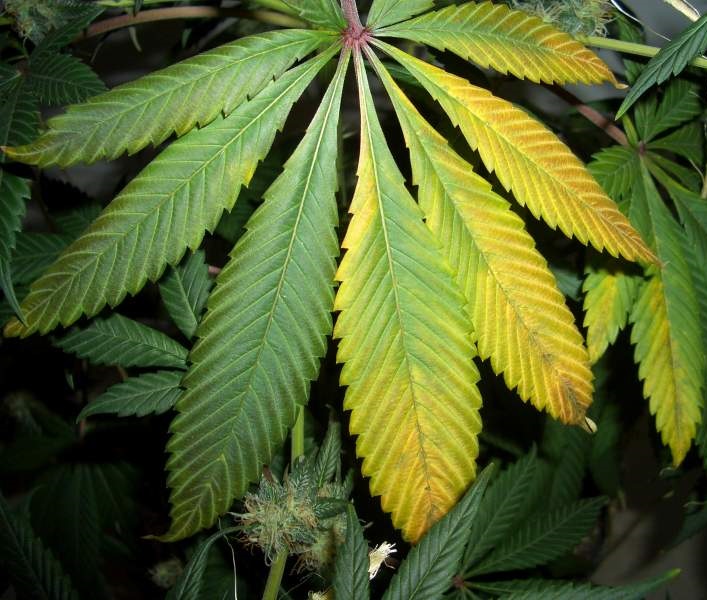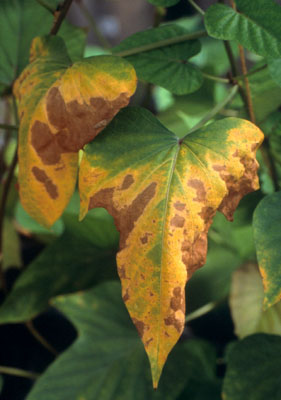In this series of articles, Growers Network talks about a few of the most common Cannabis conditions you need to watch out for. Today’s topic: Potassium Deficiency/Toxicity.

The following is an article produced by a contributing author. Growers Network does not endorse nor evaluate the claims of our contributors, nor do they influence our editorial process. We thank our contributors for their time and effort so we can continue our exclusive Growers Spotlight service.
Plant conditions can be a major headache in any grow operation and Cannabis has no shortage of them. So for today’s condition profile we’re going to discuss potassium deficiency/toxicity, a condition you may find yourself dealing with in your grow if your nutrients aren’t adjusted properly.
Quick Look
- Common Name: Potassium Deficiency/Toxicity
- Scientific Name: Potassium Deficiency/Toxicity
- Symptoms: Manifests similarly to an iron deficiency. Brown or yellow coloring in leaf tips, leaves will start to curl and may appear “burnt”. In some cases, plants may seem to stretch.
- Caused by: A large number of potential nutrient antagonisms, nutrient deficiency, pH imbalance
- Timing: Typically appears in flowering, particularly weeks 3-4, but can occur at any time
Potassium Deficiency/Toxicity
What is it?
Potassium deficiency/toxicity is exactly as it describes -- a lack of enough potassium in the soil or medium to provide enough nutrients for the plant to properly grow, or an excess of potassium that can cause a lockout of potassium. Ironically, an excess of potassium in the soil can cause potassium deficiency.
Additionally, sometimes antagonism from other nutrients may cause what appears to be potassium deficiency/toxicity. According to our vetted partners at Maximum Yield, an excess of the following can cause an apparent deficiency/toxicity in potassium:
- Nitrogen
- Potassium
- Calcium
- Magnesium

What to look for
The symptoms of a potassium deficiency manifest very similarly to those of an iron deficiency. Leaf tips will start to turn brown or yellow and leaves may also start to curl. In cases that persist, leaves may start to appear burnt. Additionally, stems will begin to “stretch” and the plants will become unusually tall or long, but structurally weak. Left untreated, chlorotic blotches will appear on leaves, followed by necrosis.

Symptoms can include:
- Leaves turning yellow or brown
- Leaves curling
- Leaves turning chlorotic or necrotic
- Stems “stretching” and growing abnormally
How to Treat/Prevent
Identification
First, you need to make sure that you actually have a potassium deficiency or toxicity problem before you start changing your nutritional supplements. If you add too many nutrients (or too few), you could be aggravating a different problem with your plants!
To identify you have the “right” deficiency, check the pH and EC of your nutrient water in the line, and test the pH and EC of the runoff. If you see a drop in EC and pH remains constant, then your pH values are correct and you can check for other issues. If your EC doesn’t drop (or drops too much), or your pH varies, then you may have another issue. Check this article out for more details about runoff issues.
However, runoff tests aren’t always the most reliable. They are cheap and fast, but not a guarantee by any stretch. They also don’t tell you precisely what you’re missing or have too much of. If you truly want to know what’s going on, you need to send in a tissue sample or soil sample to a lab and get their analysis.
Treatment
Treatment will depend on the aforementioned identification. If you find that your pH is outside of acceptable ranges (5.5-6.5), first correct your pH. If your EC is reading odd or abnormal values, then make sure there isn’t a salt buildup or precipitate in your feeding regimen.
If test results show a deficiency in calcium or magnesium, add a CalMag to your feeding regimen and see if the problem resolves. But don’t add too much, because excess of these nutrients can cause the same problem!
And if you get test results back for low potassium, the solution is simple! Add more potassium!
But be warned -- the problem might actually be caused by an excess of potassium. When that’s the case, you’ll need to start flushing your medium with pure water, slowly adding back other nutrients the plant needs. You don’t want to aggravate one problem by causing others.
Prevention
Prevention of a potassium deficiency or toxicity is relatively simple -- just monitor the soil or medium! Send regular samples into labs for testing to make sure you don’t have too much or too little. Keep an eye out for any of the aforementioned symptoms, and make sure to take notes of your feeding schedules!
One other method of prevention exists, and this is growing in a hydroponic system. Potassium deficiencies in hydroponic systems are exceedingly rare, given how easy it is for plants to uptake potassium in the nutrient solutions available for hydroponic grows.
A Few Other Things
Potassium deficiencies or toxicities don’t commonly appear early in cannabis’ life cycle. Generally, cannabis only requires relatively small amounts of potassium early on, and will start pulling much more significant amounts of it when it enters the flowering phase. Our resident growing expert says that you’ll likely start seeing potassium deficiencies or toxicities around week 3 or 4 of flowering.
So now you know a bit about potassium deficiency/toxicity and what you can do to prevent it from ruining your grow. Have additional questions about it? You should join our forum where you can post pics and ask our expert community about this topic or any other!
Happy Growing!
10 Best Gift Ideas for Cannabis Connoisseurs and Growing Aficionados (2022)
December 7, 2022Developing and Optimizing a Cannabis Cultivation System
December 14, 2021Dealing with Insomnia: How Can CBD Help?
December 10, 2020Your Guide to Sleep and CBD
December 7, 2020
Do you want to receive the next Grower's Spotlight as soon as it's available? Sign up below!
Resources:
- Want to learn more about subjects similar to those touched upon in this article? Check out our articles on subjects such as:

Do you have any questions or comments?

About the Author
Hunter Wilson is a community builder with Growers Network. He graduated from the University of Arizona in 2011 with a Masters in Teaching and in 2007 with a Bachelors in Biology.